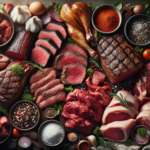In the quest for peak athletic performance, nutrition plays a pivotal role. While conventional wisdom often emphasizes a balanced diet with plenty of fruits, vegetables, and grains, a growing number of athletes are turning to a more primal approach: the carnivore diet.
This meat-only dietary strategy is gaining traction for its potential to enhance muscle building, improve recovery, and fuel intense training. This post delves into the science behind the carnivore diet and explores how it can be a powerful tool for athletes seeking to unlock their full potential.
The Carnivore Diet: Unveiling the Meat-Only Approach
Defining the Carnivore Diet
The carnivore diet, in its purest form, is an animal-based diet that eliminates all plant-based foods. It’s a dietary approach focused solely on consuming animal products.
- Allowed foods: Red meat (beef, lamb, bison, etc.), poultry (chicken, turkey), fish (salmon, tuna, mackerel, etc.), seafood (shrimp, crab, lobster), eggs (potentially, depending on individual tolerance), and animal fats (tallow, lard, butter).
- Excluded foods: All plant-based foods, including fruits, vegetables, grains, legumes, nuts, and seeds.
It is, by definition, a meat-only diet, and it is important to clarify that we’re discussing an animal-based diet in its most unadulterated form.
The Historical Precedent for Primal Nutrition
While seemingly radical in today’s context, a primarily animal-based diet has historical precedent. Anthropological evidence suggests that our ancestors went through periods where their diets consisted largely, if not entirely, of animal products. This was often dictated by environmental factors and food availability.
Many common myths about the absolute necessity of plant-based foods for survival are being challenged. While plants can provide certain nutrients, the human body is remarkably adaptable and can thrive on a meat-only diet, obtaining all essential nutrients from animal sources. This ties directly into the concept of primal nutrition – a return to the eating patterns of our ancestors.
Potential Benefits Beyond Athletics.
Although our focus is on athletic performance, it’s worth briefly mentioning other reported benefits. Many individuals experience significant weight loss, improved gut health (often due to the elimination of potentially irritating plant compounds), and increased mental clarity. These are, of course, individual results, and more research is always needed.
The Science of Protein and Athletic Performance
Protein’s Crucial Role in Muscle Building and Repair
Protein is undeniably the cornerstone of muscle growth and repair. The amino acids derived from protein intake are the literal building blocks of muscle tissue. When we engage in intense physical activity, we create microscopic tears in our muscle fibers. Protein is essential for repairing this exercise-induced muscle damage and building new, stronger tissue. This is the anabolic (muscle-building) effect of sufficient protein, a process crucial for athletes.
Optimal Protein Intake for Athletes
The Recommended Daily Allowance (RDA) for protein is often insufficient for athletes, who have significantly higher protein demands due to the stress of training. The RDA is typically set to prevent deficiencies in sedentary individuals, not to optimize athletic performance.
Recommended protein intake for athletes varies depending on the type and intensity of their training. Endurance athletes may require 1.2-1.7 grams of protein per kilogram of body weight, while strength and power athletes may need 1.6-2.2 grams per kilogram, or even higher. A carnivore diet effortlessly meets these higher protein needs, as animal products are naturally rich in protein.
Bioavailability and Protein Quality
Bioavailability refers to how well the body absorbs and utilizes a nutrient. Protein bioavailability is a critical factor, as not all protein sources are created equal. Animal proteins, consistently found in a meat-only diet, have a high bioavailability, meaning the body can efficiently absorb and use the amino acids they contain. Plant-based proteins, while valuable, often have lower bioavailability and may lack certain essential amino acids in optimal ratios.
The Carnivore Diet and Athletic Performance: Exploring the Connection
Enhanced Muscle Building Potential
The high protein content and complete amino acid profile of a carnivore diet provide the ideal foundation for muscle building. Animal products contain all nine essential amino acids, which the body cannot produce on its own and must obtain from food. Furthermore, animal fats play a role in hormone production, including testosterone, a key hormone for muscle growth and athletic performance.
Improved Recovery and Reduced Inflammation
Many proponents of the carnivore diet report reduced inflammation and faster recovery times. This may be due to the elimination of certain plant-based foods that can trigger inflammation in some individuals. Efficient protein digestion, a hallmark of a well-formulated meat-only diet, also contributes to faster recovery by providing the body with readily available amino acids for muscle repair. While more research is needed, anecdotal evidence and some emerging studies suggest reduced muscle soreness and improved recovery markers.
Energy Levels and Endurance
A common misconception is that carbohydrates are the only fuel source for the body. On a carnivore diet, the body undergoes a metabolic shift called ketosis. In ketosis, the body becomes highly efficient at burning fat for fuel instead of relying primarily on glucose from carbohydrates. This can lead to stable blood sugar levels and sustained energy, which can be particularly beneficial for endurance athletes. The constant supply of energy from fat can prevent the bonking or energy crashes often associated with carbohydrate-dependent diets.
Gut Health and Nutrient Absorption
For some individuals, eliminating certain plant foods, particularly those high in fiber or containing anti-nutrients, can lead to improved digestion and reduced bloating. A healthy gut is crucial for overall health and athletic performance, as it’s responsible for absorbing the nutrients needed for energy production, muscle repair, and immune function.
Practical Considerations for Athletes on a Carnivore Diet
Transitioning to a Meat-Only Diet
A gradual transition is recommended to minimize digestive issues. Start by slowly reducing your intake of plant-based foods while increasing your consumption of animal products. Listen to your body’s signals and adjust accordingly. Some individuals may experience keto flu symptoms (headache, fatigue, irritability) as the body adapts to burning fat for fuel. These symptoms are usually temporary and can be mitigated by staying hydrated and increasing electrolyte intake.
Ensuring Adequate Nutrient Intake
Concerns about nutrient deficiencies are often raised regarding the carnivore diet. While it’s true that some nutrients are more abundant in plant-based foods (e.g., vitamin C), a well-planned carnivore diet can provide all essential nutrients. Focus on consuming a variety of animal products, including organ meats (liver, kidney, heart), which are incredibly nutrient-dense. The question of supplementation is often debated; some individuals find it unnecessary, while others may choose to supplement with specific nutrients based on their individual needs and blood work.
Hydration and Electrolyte Balance
Increased water intake is crucial on a carnivore diet, as the body tends to flush out more water. Electrolyte imbalances (sodium, potassium, magnesium) can occur due to this increased water loss. Supplementation with electrolytes, especially sodium, is often necessary to prevent symptoms like fatigue, muscle cramps, and headaches. Practical tips include adding salt liberally to food, drinking bone broth, and considering electrolyte supplements.
Individualizing the Carnivore Approach for Different Sports
The meat-only diet can be tailored to meet the specific demands of different sports. Endurance athletes may benefit from a higher fat intake to provide sustained energy, while strength athletes may prioritize even higher protein intake to maximize muscle growth. It’s highly recommended to work with a qualified nutritionist or sports dietitian, especially when starting the carnivore diet, to ensure you’re meeting your individual needs and optimizing your performance.
Meal Planning & Food Examples
Here are some examples of typical carnivore meals and snacks:
- Breakfast: Steak and eggs, bacon and eggs, salmon with butter.
- Lunch: Ground beef with bone broth, chicken thighs, lamb chops.
- Dinner: Ribeye steak, roasted chicken, pork belly, fish with tallow.
- Snacks: Beef jerky (unsweetened), hard-boiled eggs, pork rinds.
Focus on variety by including different cuts of meat, types of seafood, and organ meats to maximize nutrient intake.
Addressing Common Concerns and Criticisms
The Sustainability and Ethical Considerations
The environmental impact of meat production is a valid concern. Choosing sustainably sourced options, such as grass-fed and pasture-raised animals, can help mitigate this impact. These farming practices often have a lower carbon footprint and promote better animal welfare. Ethical concerns related to animal welfare are also important to consider. Supporting farms that prioritize humane treatment of animals is a way to align your dietary choices with your values.
Long-Term Health Implications
Long-term research on the carnivore diet is still limited. While many individuals report positive health outcomes, it’s essential to acknowledge potential risks and benefits based on current understanding. Regular health check-ups, including blood work, are crucial to monitor your health status and identify any potential issues.
The Importance of Professional Guidance.
It is of the highest importance to work with healthcare professionals such as doctors and dieticians when making big changes to your diet, including switching to a carnivore diet. They can help to ensure you are getting the correct nutrients and remaining healthy.
Frequently Asked Questions
Will I get enough fiber on a carnivore diet?
Fiber is primarily found in plant foods. While fiber is often touted for its digestive benefits, many individuals on a carnivore diet report improved digestion without it. The body can adapt to a low-fiber diet.
Is the carnivore diet safe for everyone?
While many people thrive on a carnivore diet, it’s not suitable for everyone. Individuals with certain medical conditions, such as kidney disease, should consult with their doctor before making significant dietary changes.
How do I know if the carnivore diet is right for me?
The best way to determine if the carnivore diet is right for you is to try it under the guidance of a healthcare professional. Start slowly, listen to your body, and monitor your progress.
What about cholesterol? Won’t eating all that meat raise my cholesterol?
The relationship between dietary cholesterol and blood cholesterol is complex. Many individuals on a carnivore diet experience improvements in their cholesterol profiles, but individual responses vary. Regular blood work is essential to monitor your cholesterol levels.
Can I eat any fruit or vegetables at all?
The strict carnivore diet excludes all plant-based foods. Some individuals may choose a modified version that includes small amounts of low-toxicity fruits or vegetables, but this is no longer a true carnivore diet.
Conclusion
The carnivore diet offers a compelling alternative for athletes seeking to optimize their performance through primal nutrition.
By prioritizing high-quality protein intake from animal sources, this meat-only diet supports muscle building, enhances recovery, and provides sustained energy.
While it’s not a one-size-fits-all solution, and individual responses may vary, the carnivore diet presents a potentially powerful tool for athletes seeking to push their limits and achieve peak athletic performance through an animal-based diet.


